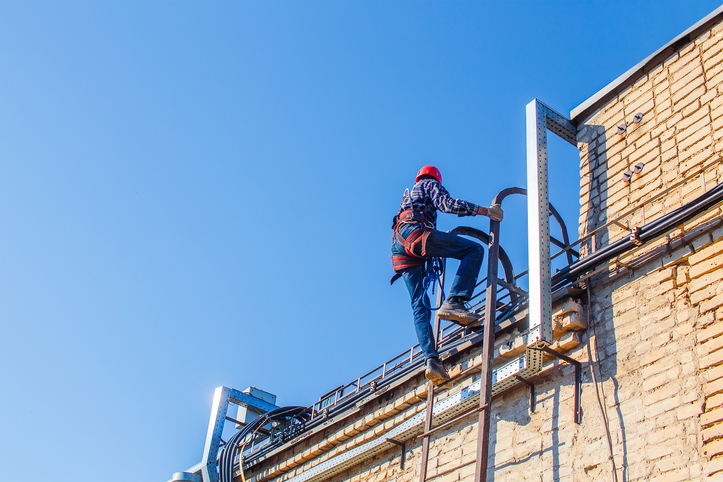Ascending to Ladder Safety—One Rung at a Time
Our analysis of OSHA’s top 10 most frequently cited standards continues with a discussion of ladder safety.
Ladders in the workplace, if not properly and safely handled, are highly dangerous to workers. In fact, the mishandling of ladders, as addressed in the Occupational Health and Safety Administration’s (OSHA’s) safety standard 1926.1053, is one of the most common workplace safety violations. In 2022, it was the third most violated of OSHA’s standards, with 2,471 total citations—over 400 more than in 2021.
Unfortunately, there is a notable upward trend in citations regarding ladders—and this growth in citations indicates that OSHA is paying particular attention to this category, which is especially worrisome as infractions can run up to $15,625 per violation. Given the growing focus on ladder safety, staying compliant is extremely beneficial—both in terms of employee safety and your organization’s bottom line.
Ladder Violations Lead to Serious Hazards
It’s hard to exaggerate the potential dangers of ladders in the workplace—in fact, globally, the United States leads in the incidence of ladder deaths. According to the National Institute for Occupational Safety and Health (NIOSH), hundreds of people die and hundreds of thousands more are injured annually due to ladder-related falls. Not only that, but the Centers for Disease Control and Prevention (CDC) estimates that over 80% of fall injuries in the United States are due to improper ladder use.
The CDC estimates that the annual national cost of ladder injuries—from lost working time, violation fines, legal considerations, medical costs, and more—is $24 billion. These hefty costs can quickly spell trouble for your organization, especially since ladder fall deaths have tripled in the last decade.
It is important to understand the current regulations within the “Ladders” safety standard and the ways to prevent violations, in order to protect your bottom line and the well-being of your employees.
Workplace Ladder Regulations
Falls are the primary workplace ladder hazard. To protect workers from ladder-related falls, OSHA enforces extensive ladder-use rules, covering areas such as:
- Maximum weights various ladders can support
- Ladder construction and assembly procedures
- Placement of ladders for the greatest safe support of workers
- Relevant fall arrest systems and when they must be used
Managers need to ensure their facilities and workers conform to OSHA ladder safety compliance requirements. Some of the key sections of this standard are outlined below, to help ensure managers begin to understand ladder safety compliance obligations.
- Supporting loads (standard 1926.1053(a)(1)):
“Ladders shall be capable of supporting [appropriate] loads without failure.”
Different ladder types must support different loads. Portable ladders, both self-supporting and not, need to be able to support at least quadruple the maximum expected load. In some circumstances, there are exceptions to these guidelines—this depends on the material that comprises the ladder, its placement angle, and more. For instance, fixed ladders must support two 250-pound loads on every rung, with considerations for ice build-up, wind, equipment, and other variables as applicable.
-
Ladder details (standard 1926.1053(a)(2)):
“Ladder rungs, cleats, and steps shall be parallel, level, and uniformly spaced when the ladder is in position for use.”
The construction details of ladder or step stool safety will greatly impact their safety. OSHA regulates specific areas of ladder design, from rung and step spacing to the shape, size, and other qualities of the rungs themselves. For ladders, there should be a minimum of 10 inches and a maximum of 14 inches between the rung centers; for step stools, the spacing should run between 8 inches and 18 inches.
Rungs, cleats, and steps should be constructed with dimples, corrugation, or the like to prevent employees from slipping while climbing the ladder. All ladder components must be surfaced to prevent punctures or snags, and only hazard warning labels are allowed to be affixed to the ladder.
OSHA also regulates the distance of ladders to one another; at least 16 inches is required between ladders, and ladders should never be tied together to extend their height, unless the ladders are specially designed for connection.
Since a single ladder is not allowed to exceed 50 feet in height, multiple ladders may be needed for particular projects. In such situations, if a worker must climb a ladder to access another ladder to reach a destination, the two ladders must be connected via a platform (with relevant fall protection measures in place).
- Fall safety (standard 1926.1053(a)(18-19)):
“Fixed ladders shall be provided with cages, wells, ladder safety devices, or self-retracting lifelines where the length of climb is less than 24 feet (7.3 m) but the top of the ladder is at a distance greater than 24 feet (7.3 m) above lower levels. Where the total length of the climb equals or exceeds 24 feet (7.3 m), fixed ladders should be equipped with … ladder safety devices; or self-retracting lifelines, and rest platforms at intervals not to exceed 150 feet (45.7 m); or a cage or well, and multiple ladder sections … .”
Ladder fall safety measures can help protect workers, regardless of height of the climb. Some of these safety measures include cages, wells, ladder-specific safety devices, and lifelines. A ladder cage is a barrier that either partially or fully encloses the ladder’s climbing space, fastened to the ladder and/or an external object—but cages are only compliant fall protection for ladders produced before November 19, 2018.
Since 2018, when cages and wells became noncompliant, OSHA has recommended ladder-specific safety devices as the penultimate fall protection. A ladder safety device is a support system which will prevent workers from falling from ladders—this may include brakes, lifelines/lanyards, or siding attachments. With these systems, fall arrest is guaranteed, which allows workers to focus on the job at hand and not be distracted by safety concerns.
Ladder Regulations Compliance
With all of this in mind, there are some steps that you can take to be compliant and protect the well-being of your employees. We will analyze some of these below.
- Review your operations: You should perform a thorough review of your operations—in any location where a ladder may be deployed, consider adding signage indicating relevant ladder hazards and regulations. Alternatively, you could employ a ladder expert to supervise and ensure adherence to all applicable rules. Regularly test ladders to ensure they can support the required load—and during every operational climb, note the load amount needed and compare that to the load regulations for the specific ladder you are using.
- Invest in training: Ladders are only safe if workers are sufficiently trained to use them properly. OSHA requires training for employees that work on or around ladders as necessary, including general fall hazard precautions, correct procedures for using fall arresting equipment, maximum load, correct placement of ladders, and more. It’s crucial to offer up-front training to your employees—but regularly scheduled refresher trainings are vital to keeping employees current with the latest ladder safety procedures.
- Strictly observe rules: Strict adherence to rules will streamline the process of creating a culture of safety within your organization. It will swiftly begin to ensure your employees care about keeping themselves—and their coworkers—safe from ladder hazards. When workers fail to follow ladder safety rules, there must be serious consequences—be it a reprimand or training assignment. Never let an employee on a ladder without fall protection equipment in place, and take the time to make sure your ladders are sufficiently constructed.
As an operations or facility manager, it is crucial that you consider ladders regulations to ensure both employee safety and avoidance of the various penalties, financial and otherwise, that come with noncompliance—including lost operational time, fines, and in the case of an injury, employee medical leave. Contact us today for help in putting ladder safety—and other worker protection protocols—in place at your facility.







